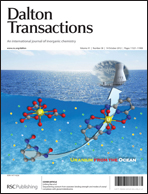The new compound LiNaFe[PO4]F was synthesized by a solid state reaction route, and its crystal structure was determined using neutron powder diffraction data. LiNaFe[PO4]F was characterized by 57Fe Mössbauer spectroscopy, magnetic susceptibility, specific heat capacity, and electrochemical measurements. LiNaFe[PO4]F crystallizes with orthorhombic symmetry, space group Pnma, with a = 10.9568(6) Å, b = 6.3959(3) Å, c = 11.4400(7) Å, V = 801.7(1) Å3 and Z = 8. The structure consists of edge-sharing FeO4F2 octahedra forming FeFO3 chains running along the b axis. These chains are interlinked by PO4 tetrahedra forming a three-dimensional framework with the tunnels and the cavities filled by the well-ordered sodium and lithium atoms, respectively. The specific heat and magnetization measurements show that LiNaFe[PO4]F undergoes a three-dimensional antiferromagnetic ordering at TN = 20 K. The neutron powder diffraction measurements at 3 K show that each FeFO3 chain along the b-direction is ferromagnetic (FM), while these FM chains are antiferromagnetically coupled along the a and c-directions with a non-collinear spin arrangement. The galvanometric cycling showed that without any optimization, one mole of alkali metal is extractable between 1.0 V and 5.0 V vs. Li+/Li with a discharge capacity between 135 and 145 mAh g−1.
![Graphical abstract: Synthesis and characterization of the crystal structure, the magnetic and the electrochemical properties of the new fluorophosphate LiNaFe[PO4]F](/en/Image/Get?imageInfo.ImageType=GA&imageInfo.ImageIdentifier.ManuscriptID=C2DT30739A&imageInfo.ImageIdentifier.Year=2012)
You have access to this article
 Please wait while we load your content...
Something went wrong. Try again?
Please wait while we load your content...
Something went wrong. Try again?
![Graphical abstract: Synthesis and characterization of the crystal structure, the magnetic and the electrochemical properties of the new fluorophosphate LiNaFe[PO4]F](/en/Image/Get?imageInfo.ImageType=GA&imageInfo.ImageIdentifier.ManuscriptID=C2DT30739A&imageInfo.ImageIdentifier.Year=2012)

 Please wait while we load your content...
Please wait while we load your content...